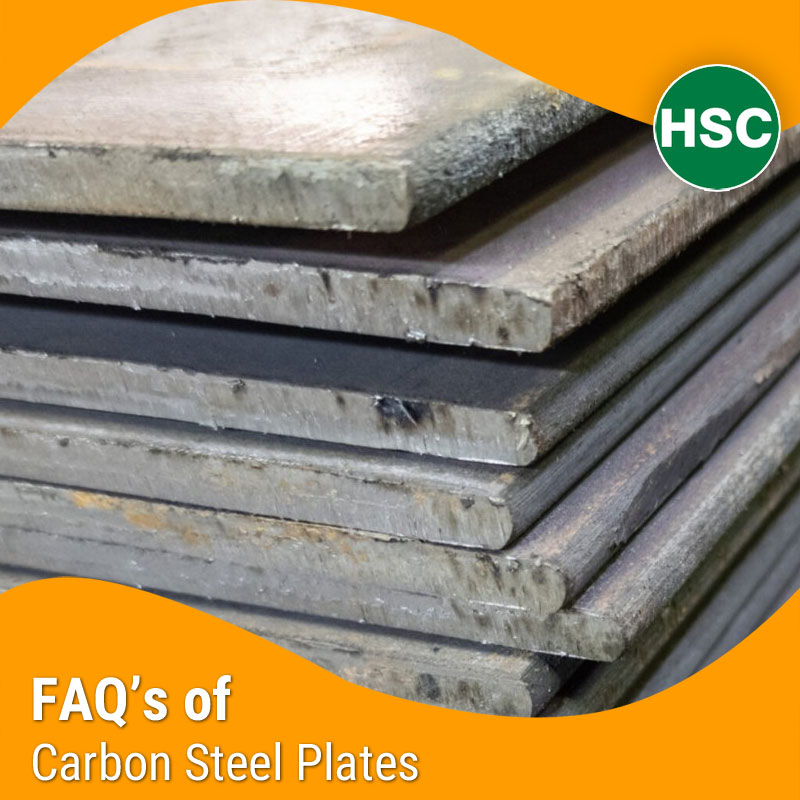How Much Carbon is Present in Carbon Steel Plates?
When buying carbon steel plates, one of the most frequent buyer queries is:
“What is the carbon content?”
The answer depends on the grade and standard you’re choosing.
Low Carbon Steel Plates: Less than 0.30% Carbon
Medium Carbon Steel Plates: 0.30% to 0.60% Carbon
High Carbon Steel Plates: Above 0.60% Carbon
At Hindustan Steel Corporation, we stock and export all three categories.
Why Does Carbon Content Matter in Steel Plates?
Carbon content directly affects:
- Strength
- Toughness
- Hardness
- Weldability
Higher carbon means stronger steel, but also lower ductility and weldability.
Lower carbon means easier welding and better formability.
Carbon Levels in Popular Carbon Steel Plate Grades
| Grade | Approx. Carbon Content |
|---|---|
| ASTM A36 | 0.25% Max |
| IS 2062 Grade B | 0.22% Max |
| ASTM A516 Gr 70 | 0.27% Max |
| EN 10025 S275 | 0.25% Max |
| EN 10025 S355 | 0.23% Max |
| JIS G3101 SS400 | 0.25% Max |
| ASTM A283 Gr C | 0.24% Max |
For critical projects, we supply plates with certified chemical analysis.
How Carbon Content Affects Steel Plate Applications
| Carbon Level | Typical Applications |
|---|---|
| Low Carbon (<0.30%) | Structural fabrication, bridges, tanks |
| Medium Carbon (0.30–0.60%) | Machinery parts, rail components |
| High Carbon (>0.60%) | Wear parts, knives, tools |
Most carbon steel plates used in fabrication and construction fall in the low to medium carbon range.
Carbon Content Limits in Global Standards
| Standard | Max Carbon % |
|---|---|
| ASTM A36 | 0.25 |
| ASTM A516 Gr 70 | 0.27 |
| IS 2062 Grade B | 0.22 |
| EN 10025 S275 | 0.25 |
| EN 10025 S355 | 0.23 |
| JIS G3101 SS400 | 0.25 |
Exact limits can vary slightly by plate thickness.
Thickness vs Carbon Content
- Thicker plates (>25 mm) may have slightly higher carbon levels due to rolling and cooling requirements
- We provide thickness-wise chemical analysis for all plates.
Heat Treatment Impact on Carbon Content
Carbon doesn’t change during heat treatment, but its effect on plate properties changes.
| Process | Effect |
|---|---|
| Normalizing | Refines grain, improves toughness |
| Quenching & Tempering | Boosts hardness & strength |
| Annealing | Improves ductility |
Weldability Considerations
- Low carbon steels (like A36, IS 2062) – Excellent weldability
- Higher carbon steels (medium/high) – Need pre-heating and post-weld heat treatment
- Hydrogen cracking risk increases with higher carbon content.
Surface Finish & Testing Services
We offer:
- Carbon content certification
- Spectro analysis report
- Third-party inspection (SGS, TUV, Lloyd’s)
- Shot-blasting & primer-coating for corrosion protection
Technical Standard & Chemical Composition Differences
| Parameter | IS 2062 Grade B | ASTM A36 |
|---|---|---|
| Standard | IS 2062 (Indian) | ASTM A36 (American) |
| Carbon Content | 0.22% max | 0.26% max |
| Manganese | 1.50% max | 0.60–0.90% |
| Sulphur & Phosphorus | 0.05% max | 0.04% max |
| Silicon | Optional | Optional |
Export Support for Carbon Steel Plates with Specified Carbon Content
We export low and medium carbon steel plates to:
- UAE
- Saudi Arabia
- South Africa
- Vietnam
- USA
CIF, FOB, and Ex-Works options available
Heat Treatment Options
| Condition | IS 2062 | ASTM A36 |
|---|---|---|
| As-Rolled | ✅ | ✅ |
| Normalized | Available (on request) | Optional (Rare) |
| Impact Tested Grades | J0/J2 for IS 2062 | Optional for A36 |
Buyer Tip: How to Specify Carbon Content in Your Inquiry
When sending RFQ:
- Mention grade/standard (e.g., A36, IS 2062)
- Specify if max carbon level certification is needed
If required, request low carbon variant for improved weldability
Certifications & Test Reports for Carbon Content
We provide:
- Mill Test Certificates (MTC) with carbon percentage
- Spectrochemical analysis
- Third-party lab test reports
- Impact test and UT reports (on request)
FAQs Carbon Content in Carbon Steel Plates
How much carbon is there in IS 2062 Grade B?
Max 0.22%.
Does higher carbon mean stronger steel?
Yes, but weldability reduces.
Which grade has the least carbon content among common plates?
IS 2062 and A36 are both low-carbon
Is carbon content same across all thicknesses?
Slight variations based on thickness and rolling.
Which steel plate is best for easy welding?
A36 or IS 2062 low-carbon grades
Can carbon content affect the price of steel plates?
Yes, grades with low or controlled carbon may cost more.
Is high carbon steel suitable for structural fabrication?
Not recommended
Where can I get a quote for low carbon steel plates?
WhatsApp, Email, or Call us for a fast quote
Want guaranteed carbon content within your project spec?
Contact Hindustan Steel Corporation today.
Ask for:
- Carbon percentage-based stock availability
- MTC samples
- Best price for low and medium carbon plates

